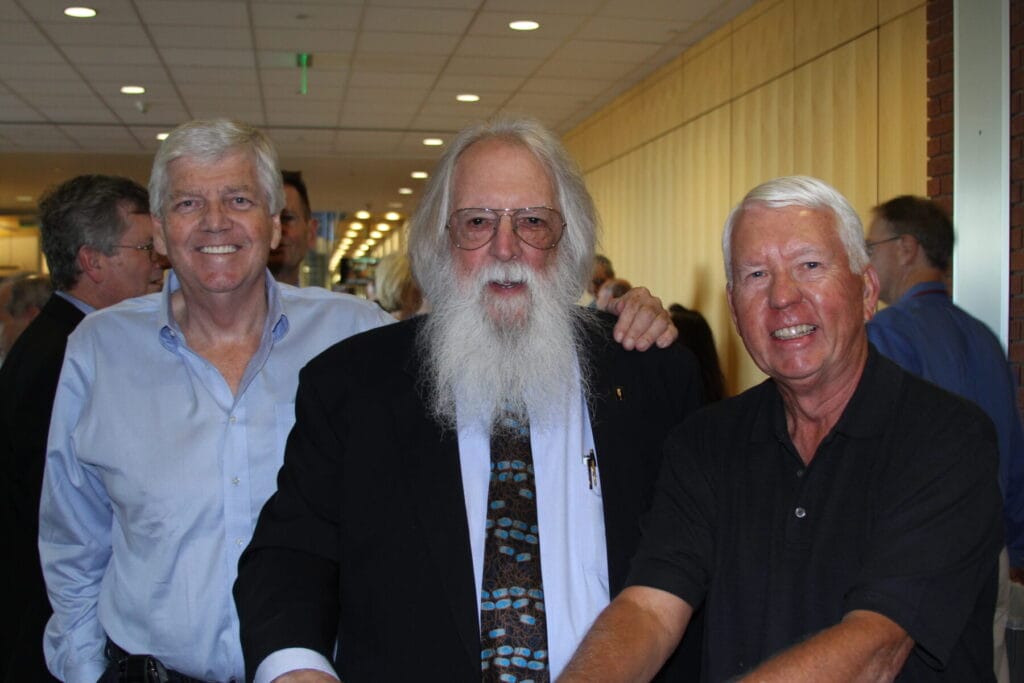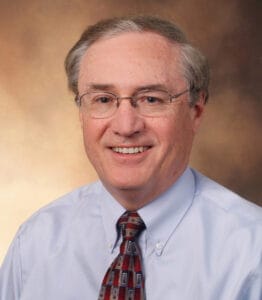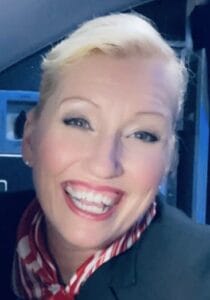This is the first in a series of profiles of former faculty and staff members of ASU’s Biodesign Institute in celebration of its 20th anniversary.
Engineering microbes to fight deadly diseases. Constructing research buildings that promote collaboration through their very design. Producing COVID-19 test kits to save lives in Arizona. These are just a few of the ways that faculty, staff, students and volunteers in the Biodesign Institute at Arizona State University have been making an impact and improving lives around the world since 2004.
Through their collaborative and supportive approach as a community of scientists, the Biodesign team looks at problems differently, scales innovation faster and challenges the impossible. In this series, former members of the Biodesign Institute share their favorite memories from ASU and how they have carried the spirit of collaborative innovation into all of their endeavors.
Curiosity, teamwork and a touch of adventure
Roy Curtiss III — director, Biodesign Center for Infectious Diseases and Vaccinology, 2004–15
Roy Curtiss came to Arizona State University as co-director of the Biodesign Center for Infectious Diseases and Vaccinology in 2004, becoming director in 2007. Curtiss says his motivation then — and throughout his career — has been “Curiosity; the discovery of new things and achieving success in research endeavors.” Curtiss is a geneticist and microbiologist, but he admits he enjoys exploring all areas of science.
“I am self-motivated,” he says. “I work for myself.”
While his motivation has always come from within, the successful implementation of his ideas has been a team effort.
“While at Biodesign at my peak,” he says, “I had eight grants with some 50 members of my research group,” he says.
Curtiss’ research used genetic manipulation of microbes to address problems of global concern, including the development of live vaccines to reduce the destruction and death caused by infectious diseases affecting fish, poultry, swine, cattle and humans. His group also developed a new production method that lowered the cost of biofuels, making renewable energy more of an everyday reality.
While his team was working toward those successes, their interactions went beyond what was required to get the job done.
“We enjoyed life, living and discovery,” Curtiss says.
One day, Curtiss and Charles Arntzen, the institute’s founding director, were enjoying life from the roof of Biodesign building A when they made the discovery that the door had locked behind them. Curtiss’ challenge then was “… getting Charlie to climb down a ladder and navigate the cross bridge to building B, circle back and unlock the door from the attic to the roof to enable my escape!”

Arntzen’s fearlessness ensured Curtiss’ string of successes at Biodesign would continue. He has filed 20 patent applications that have yielded 18 U.S. patents. His proudest achievement is a project to develop a thermo-stable, needle-free vaccine for infants, funded through the Gates Foundation’s Global Grand Challenges initiative to solve key health and development problems.
Curtiss left the Biodesign Institute in 2015 to become a professor in the College of Veterinary Medicine at the University of Florida, where he continues his efforts to develop and license vaccines to control infectious diseases. An ASU professor emeritus, he continues to follow his advice for researchers who will follow him.
“Take risks, adventure through life exploring new options and opportunities and be kind and generous to all people you meet.”
From chicken coops to research buildings
Michael Mobley — associate director, 2002–10
The opportunity to welcome Roy Curtiss to Biodesign in 2004 presented Associate Director Michael Mobley with a chicken and egg problem.

“I was trying to find a temporary campus location for Roy Curtiss' chickens before the Biodesign vivarium was completed,” Mobley recalls. “I searched through nearly every building on the east side of campus. I finally negotiated the demolition of an engineering storage shed to build a temporary vivarium that allowed Professor Curtiss to come to ASU.”
Mobley’s contributions included much more than engineering coops.
“I was responsible for programming the construction of Biodesign buildings A and B,” he says. “Later, I was primarily responsible for external relations, grants development, technology transfer and the Impact Accelerator.”
Created in 2009, the Impact Accelerator, in partnership with Skysong Innovations, expedited the translation of scientific breakthroughs into beneficial societal impacts, providing a bridge between discovery and delivery that also produces economic returns for the state of Arizona.
Mobley’s building programs were crucial to making those discoveries possible by ensuring the institute’s day-to-day operations could be effective. He says a key component was the inclusion of a central atrium; a 450-foot shared space spanning the length of buildings A and B that allows natural light to flow into all four levels of the facility. It has also provided a gathering space that has helped foster successful collaborations through events such as all-hands meetings, lectures, dinners, mixers and performances.
Barbara Hendricks, project manager for the Gould Evans architectural design firm (now Multistudio), said at the time, “The idea of the atrium was bold for a university where space is at a premium. But it was championed by Michael Mobley, based on their goal of creating collaboration and a heightened sense of community. It has exceeded expectations, becoming a key gathering space for the researchers and offering spectacular lines of sight throughout the facility that are extremely energizing."
The atrium was only one of the innovations that earned the institute the 2006 Laboratory of the Year award from R&D magazine.
Mobley, who earned his chemistry PhD at ASU, retired from the university and continues to pursue his passion, “the discovery of new things and achieving success in research endeavors.” With the assistance of Biodesign Emeritus Professor Su Lin, he recently published experiments on photon diffraction. And he is CEO of eHealth Nexus, the company he founded in 2011 to produce next-generation solutions to health care challenges.
Putting values into action every day
Kim Danielson — staff volunteer, 2020
Kim Danielson isn’t a person you might expect to find working at the Biodesign Institute. She has a BA from ASU — in German. But the work that she participated in as a volunteer was not only important; it saved lives.

“When Arizona was first hit by the COVID-19 pandemic in 2020, I volunteered to help make the test kits,” Danielson says.
Those kits, pioneered by Biodesign’s Virginia G. Piper Center for Personalized Diagnostics, were for a saliva-based diagnostic COVID-19 test — rather than requiring a nasal swab — making diagnostic testing easier, less expensive and faster to deploy throughout the state. By October 2021, the institute had completed 1 million tests and earned the Arizona Innovator of the Year award in the academia category of the Governor’s Celebration of Innovation.
“I had all the CITI research certificates needed to make testing kits,” says Danielson, who previously worked on the staff of ASU’s Edson College of Nursing and Health Innovation. “And I couldn’t imagine a more purposeful thing to do than to step up and volunteer to make the kits. We were providing a mission-critical item when there was a critical need in the state. Our teamwork helped stem the effects of the pandemic in its early days.”
Danielson realizes her work helped save lives, and she says it changed hers.
“I saw this as the perfect opportunity to really live out the ASU Charter and mission, to take fundamental responsibility for the community we serve,” she says. “I purposefully chose to live my values and make sure that where I worked — every day and in every task I did — I was appreciated for my contributions and my core values. That was a defining moment in my life, and every day has been better since.”
Today, Danielson is a grant facilitator in the W. P. Carey School of Business, training underserved individuals for careers in information technology.
“I love it when the underdog wins!” she says. “I like to see people who need a great job get trained and hired into a welcoming place where they are valued and paid a salary that can feed their family.” She also puts her German degree to use as an international flight attendant and is learning Greek this year to add to her skillset.
Danielson offers this advice to her trainees and anyone else who wants to make a difference: “Don't scale back for any reason. Keep moving forward at light speed and beyond!”
